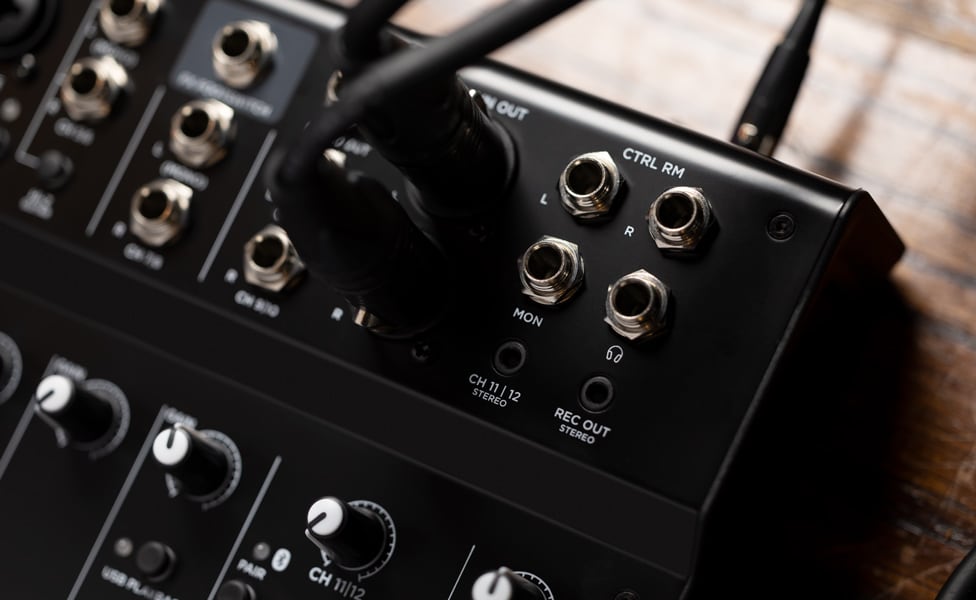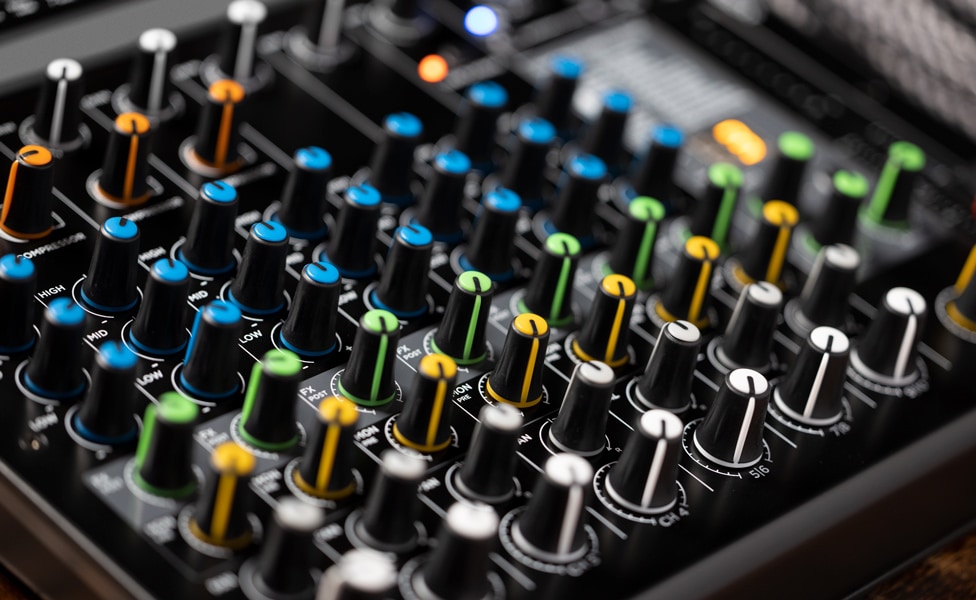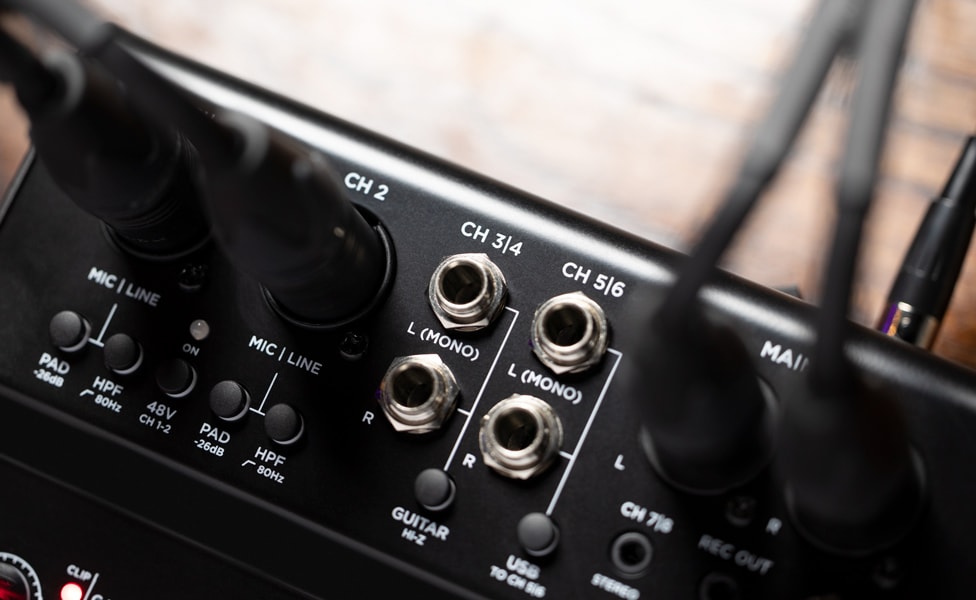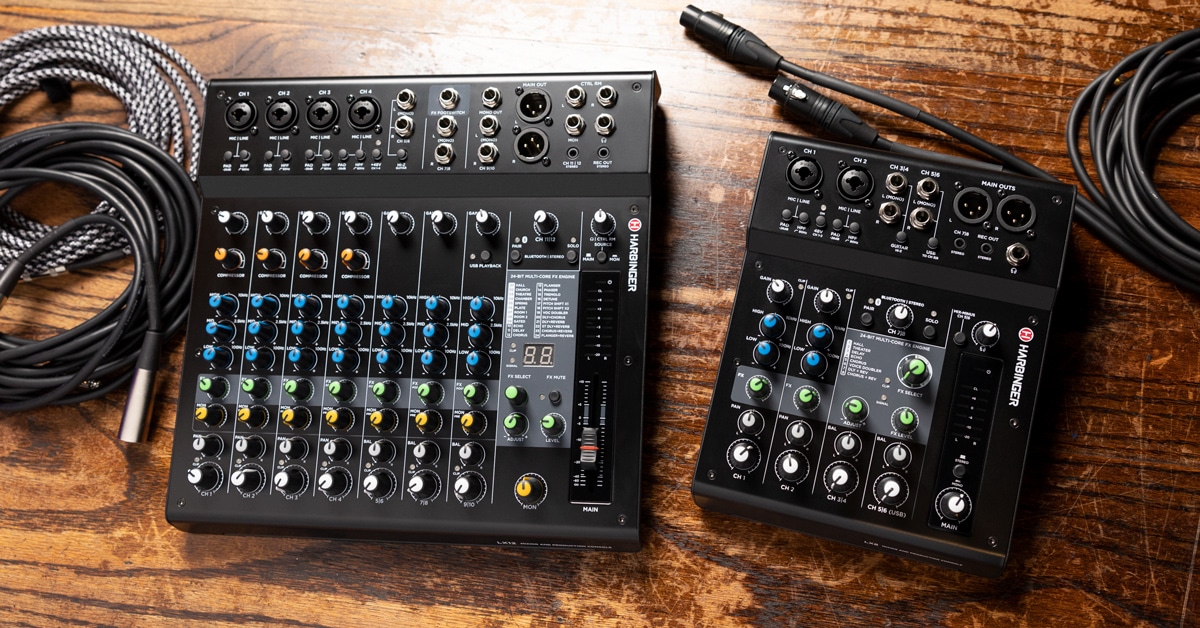Founded in 2003, Harbinger Pro Audio has been quietly developing a reputation over the past several years for products that deliver great sound and ease of use while remaining remarkably affordable for the working musician. Available exclusively at the Guitar Center companies, the compact Harbinger LX8 and LX12 mixers are a perfect example of the thinking behind developing products that deliver this level of value. We sat down with Harbinger product manager, Patrick O’Connor, one of the main figures responsible for the current generation of Harbinger designs, to have a conversation about why the LX8 and LX12 are expected to be the choice for many musicians.
Mixers are viewed as very utilitarian products, so as you were drawing up your initial plans for the new LX mixers, what did you feel were the “must-have” features to get the job done, particularly as compared to the LV series?
Patrick O'Connor: As you say, mixers are really a utility product. They’re like power tools at home for fixing stuff—the Swiss Army knife of the audio world.
At a high level, the current LV series is focused on offering a wide range of choices with different numbers of mic pres and channels. With the new LX mixers, we focused on just two specific configurations: a two-mic input configuration and a four-mic input configuration. In both cases, what we wanted to do was to provide you that I/O, onboard effects and USB connectivity. We designed them to make these mixers equally useful in live performance and for recording at home. Both models have a built-in USB audio interface so that you can record with your computer, and we’ve included some software that helps you start recording immediately with a great sound, with features specifically focused on guitarists.
What type of I/O does the USB offer you?
It's straight stereo, so you get your stereo mix into the computer, and then you get stereo back to the mixer for monitoring.
Since you made these mixers to serve both live performance and home recording, was there any aspect of these mixers that catered to one over the other? What overlapped?
When you have a mixer that you're going to be throwing into your gig bag and taking with you when you perform, it's really important for it to be compact and to put a lot of stuff into that very compact format. We built them to be compact without being cramped for operation. We also chose to use balanced XLR connectors for the main outputs. In a typical live performance, you’re going to want to be hooking up with XLRs on stage going out to your powered speakers. XLR is the ideal connector type for that.
Specifically on the LX12, you'll find that we put in a fully dedicated monitor-mixing bus, so you can have the mix that you provide to your audience and a completely different mix that is going into your monitors for the people who are performing. That obviously works for your live performance, but it can also serve you really well when you're recording at home if you need your talent to have a different mix, or you're doing an overdub and you want to hear different stuff while you're overdubbing the original track that you laid down.

As you’re talking about the ability to set up dual mixes on the LX12, it brings to mind the idea of people using these as personal mixers on stage, rather than just front-of-house.
Absolutely. That's one of the things that we think people will really find them helpful for. As a keyboard mixer, for example, or if you're a drummer, you can bring in different sources, like your main kit and maybe a sample trigger pad. You can bring in a click track. You can even have a backing track from the computer. All of that can be happening together. Also, they've got a great headphone out, so you can be monitoring that with headphones or in-ear monitors, while still sending your mix out to the house.
Obviously, one of the big things for a live performance application is how easy the mixer is to use in what may be a dark environment. What was your approach to that here?
This is a really classic design strategy with mixers where you want to let people know what each knob or button does at a real quick glance. Let’s take a look at these mixers. If it's a blue knob, you know that has to do with setting up your EQ, the basic tone of your sound. If it's a green knob, that's going to be about getting you effects. And if it is a yellow knob, it is that dedicated monitor mix that I mentioned. Finally, the white knobs all have to do with setting volume levels. That's the kind of thing that you do to make sure that, in the heat of battle, you don’t make the wrong move.
As we’re looking at them right now, one thing that jumps out are the four built-in compressors on the LX12, which is something we’re seeing more and more on mixers at this level. What kind of compressors are we looking at there?
That’s right. What’s great about these compressors is that they're super easy to use. Again, really made for that “heat-of-battle” experience. It's just a single knob, unlike what you’ll find on most outboard compressors. As you turn that knob up, you're both compressing your sound and adding makeup gain, so you don’t get quieter. The sound there becomes better controlled, and it really brings it out in the mix. We almost think of these as the “focus” knobs. They’re great for vocals, acoustic guitar, bass and also drums. So, you got four mic pres on the LX12. You can mic up a drum kit where you have kick, snare and maybe a couple overheads, and those compressors can be great for managing those levels.

Do you know what ratio they’re compressing at? Is it that 3:1 or 4:1 ballpark?
It’s a fixed compression ratio of 2:1, but the compressor threshold and make-up gain adjust as you turn the knob. So, we give you sort of gentler compression at lower levels and more aggressive compression at higher levels, and it's just kind of the “automagically”-does-what-you-want-it-to-do knob.
Are they introducing any sonic coloration or are these more on the transparent side?
They’re more on the transparent side. They're meant to really let your tone shine through but manage your levels for you.
I want to dig in a little more to the digital side of things. You have Bluetooth, which is not as common on mixers at this level. When you decided to add that, what was the real-world application you were envisioning?
Bluetooth is one of the things where we think we're doing something pretty cool. Most mixers do not have a Bluetooth input, and we realize that Bluetooth is really the way that many musicians are listening to music, reviewing music and learning music.
So, for instance, let's say that you're using one of these mixers in your practice room, and you're playing with your band, and you're learning a song together. And somebody says, “There's a great recording of this that I heard on YouTube. Let's just check it out real quickly because I think that's the feel we're really going for.” Well, you can quickly pull that track up on your phone and immediately hear it through your main system that everybody's listening to, instead of everybody trying to crowd around and listen to that little phone speaker. That’s an experience I've often had in my own practice sessions with my band. Bluetooth has become a really valuable thing.
If you're a live performer, what are you going to do most of the time? You're waiting to play. You're maybe in a small space, and they say, “Hey, can you put on a little music before you play?” “Great. I'll just Bluetooth some tracks to the mixer.” We have a solo button for that Bluetooth input, so you hit that button, and now, the only thing coming through the mixer is your phone. All of your live mics and everything else are muted, so there's no extra noise. And then, when you're done with that, you just take off that solo, and you go into playing. That’s great for break music in between sets, too, obviously.

Even taking that a step further, it seems like that feature would be great for podcast production, particularly with the LX8, right?
Exactly. Let's say that you want to be doing podcasting stuff, and there's something you've already got on your phone ... some sound that you want to play in there. Bang. You can immediately get that into the mixer and over to your computer through USB. And that goes for any audio on your phone, like if you recorded a quick memo recording on your phone of a song idea. So, we really see Bluetooth as having a lot of great applications, and we anticipate it's going to show up on more and more pro audio products like this throughout the music industry.
I want to talk a little bit about the effects. On the larger LX12, you've got 24 different effects and on the LX8, there are eight. How did you arrive at your final effects list?
The reality is, for live performance especially, and even if you're using these in studio, the number-one thing that's going to get used the overwhelming majority of the time is reverb. So, we approached it with that in mind. You'll see that we actually kind of highlight which effects are the reverb and which are the rest. Again, we really wanted to make it clear, so that in the middle of a set in a dark club, the person running the mix isn’t going to select the wrong thing. Essentially, we’ve got a great selection of reverbs, from small to large. And then, you know, on the LX8, you see some of the stock things that you really need. Chorus is great if you're going to be doing acoustic guitar, for instance. Vocal doubler kind of speaks for itself. It gives you a little bit of that fattened-up vocal, a bit of a Beatle-esque kind of experience. And then, on the LX12, which has a lot more effect choices on it, you get to get into more of that fun stuff.
I noticed that there's an effects footswitch jack on the LX12. Is that just for turning an effect on or off?
Exactly. The way that would be classically used, is when you're standing up in front of an audience, and you're singing your soulful ballad with lots of nice reverb on there. You sound fantastic. Then, you want to stop playing, and you want to tell everybody to tip the wait staff. So, you want to hit that pedal, turn off the reverb for a second, and make your announcement. Now, you’re going to go back to your musical expression. Bang. Back comes on the effects. Or maybe you're using the chorus for your acoustic guitar, like I just said. Now, you can kick it in and out whenever you need to for different parts of the song.

I’m glad you brought up guitar. Earlier in the conversation, you mentioned that there’s some bundled software, really geared towards getting you a great guitar sound if you’re doing some recording. Can you touch on that a little bit?
Yeah. So, you'll see that the first input channel that has 1/4" jacks available, there's a Hi-Z switch. And that Hi-Z switch matches the impedance of the input to the output impedance from your instrument—an electric, acoustic or bass guitar. Impedance matching is really important because it ensures that you don’t lose any of your tone, which can occur if impedances aren't properly matched. So, that's why a Hi-Z input is essential. And, by the way, the reason we put it on the first channel with 1/4" jacks is so you don’t lose any mic preamps in order to be able to use a guitar input.
Now, once you've got that Hi-Z input in use—number one, when you're playing live, it's great because you can take acoustic guitars and bass guitars direct, which is a real classic use for that. But when you're doing the recording aspect of this, and you're using the USB, the great thing is you can track acoustic guitar, bass or electric guitar. And when you track electric guitar, you can come in unprocessed, go into your software through USB, and now you can use all your plug-ins and capabilities on the computer. We’ve extended what you can do because we include Torpedo Wall of Sound software, which was developed by Two-notes Engineering and is widely recognized as a great way to get superior electric guitar tracked when you're recording. They have fantastic impulse responses for guitar cabinets, and it ensures that you get real in-the-studio sound from your electric guitar tracks, superior to what you would get if you were just using the processing built into something like GarageBand.
So, these are more than just mixers for your jam room or small gig?
That's right. We've managed to tack in a tremendous amount of capability into compact footprints, without it becoming overwhelming or difficult to operate.





